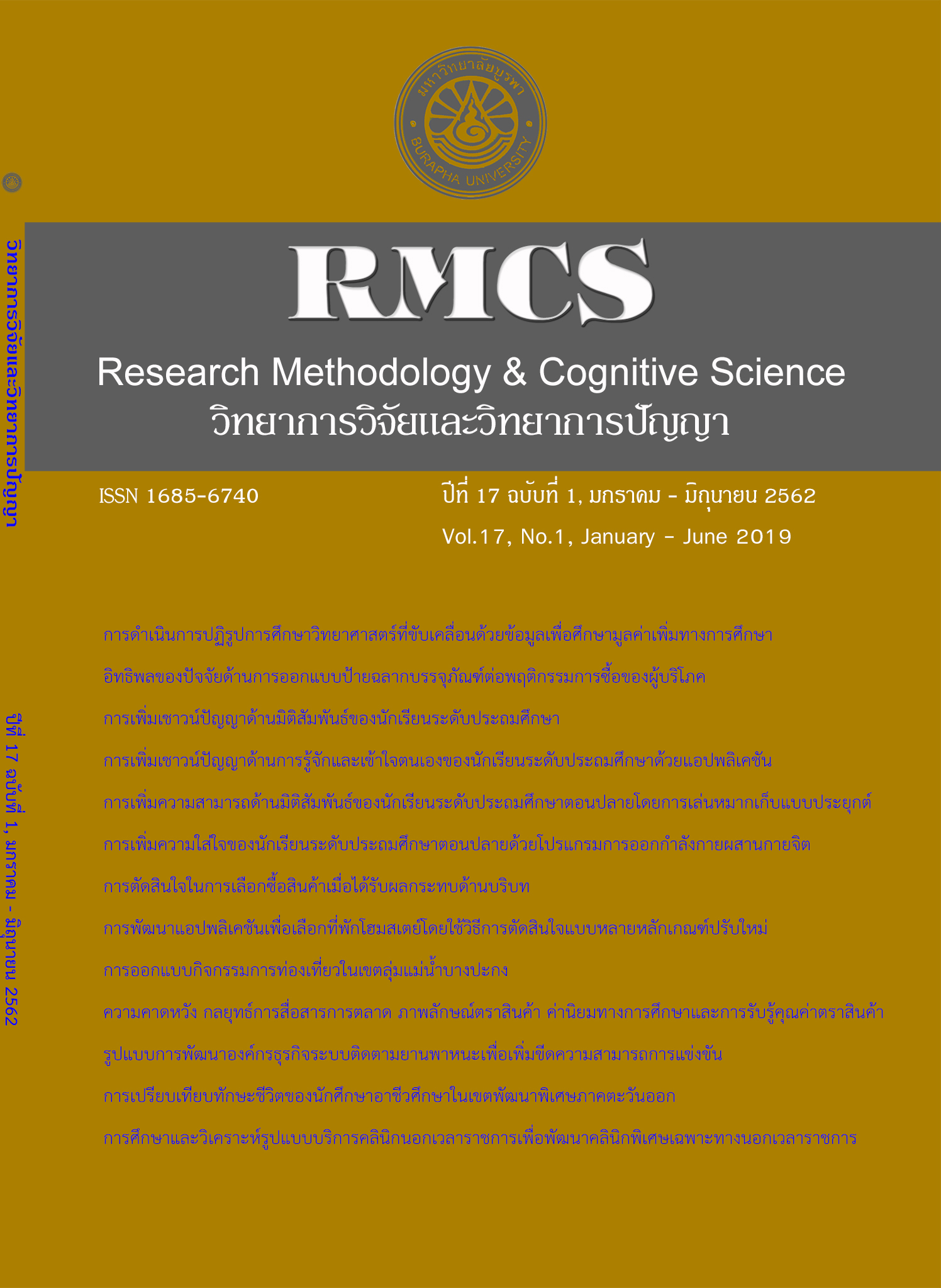Influence of the Design Factors of Package Labeling on Consumer Purchasing Behavior: an Event-Related Potential Study
Main Article Content
Abstract
The objectives of this research were 1) to develop novel package labeling for a sugar product by employing three design factors based on the sugar product itself and traditional farmer life, 2) to evaluate the recognition and satisfaction of consumers as measured by changes in N200 and P300 brainwaves, and 3) to compare the purchasing behavior of consumers depending on the package labeling as derived from brainwave and behavioral results. Data were collected from sixty women, aged between 25-60 years old in Chon Buri province by using purposive sampling method. The research instruments comprised the Neuroscan machine and the style of package labeling applied to the product. Descriptive statistics, t-test, and the repeated-measures ANOVA were used to analyze the data.
The results were as follows:
- The product package labeling, including the use of three design factors and two compositions, including unity and point of interest, resulted in 216 package labeling variations.
- The brainwave analysis revealed that the packaging which had an exact product picture, shaded pink color, and bold font earned the recognition and satisfaction of consumers, whereas the behavioral data showed an altered picture, tinted pink color, and italic font earned the recognition and satisfaction of consumers.
- Sugar sales with the package labeling derived from brainwave data were the strongest. This indicates that a neurophysiological approach can effectively guide and successfully influence package labeling, and play an important role in the prediction of consumer purchasing behavior.
Article Details
References
เพ็ญประภา เพชระบูรณิน. (2557). ปัจจัยที่ส่งผลต่อการเลือกปลูกอ้อยของเกษตรกรในอําเภอนํ้าพอง จังหวัดขอนแก่น. ใน การประชุมวิชาการเสนอผลงานวิจัยระดับบัณฑิตศึกษา ครั้งที่ 15: The 15th Graduate Research Conferences (หน้า 449-460). ขอนแก่น: มหาวิทยาลัยขอนแก่น.
Arias-Carrión, O., Stamelou, M., Murillo-Rodríguez, E., Menéndez-González, M., & Pöppel, E. (2010). Dopaminergic reward system: A short integrative review. International Archives of Medicine, 24(3), 1-6.
Baxter, M. G., & Murray, E. A. (2002). The amygdala and reward. Nature Reviews Neuroscience, 3(7), 563-573.
Dhir, S., & Sharma, B. (2012). Packaging: Changing with the change. International Journal of Research in Management, 4(2), 113-121.
Ding, Y., Guo, F., Zhang, X., Qu, Q. & Liu, W. (2016). Using event related potentials to identify a user's behavioural intention aroused by product form design. Applied Ergonomics, 55, 117-123.
Edmonds, W. A., & Kennedy, T. D. (2017). An applied guide to research designs: quantitative, qualitative, and mixed methods (2nd ed.). Los Angeles: Sage Publications.
Etzel, W., & Stanton. (1997). Marketing. (13th ed.). New York: McGraw-Hill.
Guo, F., Ding, Y., Wang, T., Liu, W., & Jin, H. (2016). Applying event related potentials to evaluate user preferences toward smartphone form design. International Journal of Industrial Ergonomics, 54, 57-64.
Gravetter, F. J., & Forzano, L. B. (2012). Research methods for the behavioral sciences (International ed.). Wadsworth: Cengage Learning.
Kotler, P., Bowen, J. T., Makens, J., & Baloglu, S. (2017). Marketing for hospitality and tourism. Boston: Pearson Education.
Khushaba, R. N., Greenacre, L., Al-Timemy, A., & Al-Jumaily, A. (2015). Event-related potentials of consumer preferences. Procedia Computer Science, 76, 68-73.
Kotler, P. (2012). Marketing Management. New Jercey: Pearson Education.
Lindström, M. (2008). Buy ology: Truth and Lies about Why We Buy. New York: Broadway Books.
Mendoza-Halliday, D., Torres, S., & Martinez-Trujillo, J.C. (2014). Sharp emergence of feature selective sustained activity along the dorsal visual pathway. Nature Neuroscience, 17(9), 1255-1262.
Omigie, D. An intracranial EEG study of the neutral dynamics of musical valence processing
Omigie, D., Dellacherie, D., Hasboun, D., George, N., Clement, S., Baulac, M., & Samson, S. (2014). An intracranial EEG study of the neural dynamics of musical valence processing. Cerebral Cortex, 25(11), 4038-4047.
Poole, B. D., & Gable, P. A. (2014). Affective motivational direction drives asymmetric frontal hemisphere activation. Experimental Brain Research, 232(7), 2121-2130.
Rangan, V., Das, N., & Gerald, Z. (1998). The pedagogy of executive education in business markets. Journal of Business-to-Business Marketing, 5(1/2), 65-70.
Simone, K., Enrique, S., & Jurgen, G. (2016). Multiple “Buy Buttons” in the brain: Forecasting chocolate sales at point-of-sale based on functional brain activation using fMRI. NeuroImage, 136(1), 122–128.
Solnais, C., Andreu-Perez, J., Sánchez-Fernández, J., & Andréu-Abela, J. (2013). The contribution of neuroscience to consumer research: A conceptual framework and empirical review. Journal of Economic Psychology, 36, 68-81.
Touhami, Z. O., Benlafkih, L., Jiddane, M., Cherrah, Y., Malki, H. O. E., & Benomar, A. (2011). Neuromarketing: Where marketing and neuroscience meet. African Journal of Business Management, 5(5), 1528-1532.

